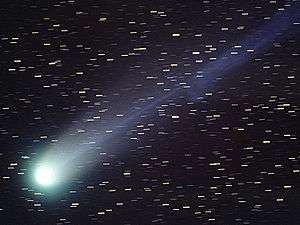92P/Sanguin
| Discovery | |
|---|---|
| Discovered by | Juan G. Sanguin |
| Discovery date | October 15, 1977 |
| Orbital characteristics A | |
| Epoch | November 17, 2014 |
| Observation arc | 36 years |
| Observations used | 896 |
| Aphelion | 8.89 AU |
| Perihelion | 1.82 AU |
| Semi-major axis | 5.36 AU |
| Eccentricity | .659521857266038 |
| Orbital period | 12 years |
| Inclination | 19.44339335368171 |
| TJupiter | 2.410 |
| Dimensions | 2.38 km |
| Comet total magnitude (M1) | 10.5 |
| Last perihelion | June 15, 2013 |
| Next perihelion | 2025 |
92P/Sanguin, also called Sanguin's Comet or Comet Sanguin, is a Jupiter-family comet discovered on October 15, 1977 by Juan G. Sanguin at Leoncito Astronomical Complex. It completes a single rotation approximately every 6 days.[1]
References
- ↑ Snodgrass; et al. (June 25, 2011). "The nuclei of comets 7P/Pons-Winnecke, 14P/Wolf and92P/Sanguin" (PDF). Astronomy & Astrophysics. Retrieved September 6, 2015.
External links
| Periodic comets (by number) | ||
|---|---|---|
| Previous 91P/Russell |
92P/Sanguin | Next 93P/Lovas |
This article is issued from Wikipedia - version of the Wednesday, December 30, 2015. The text is available under the Creative Commons Attribution/Share Alike but additional terms may apply for the media files.

